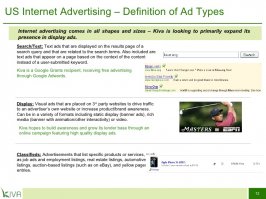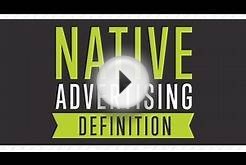Ad : For Web advertising, an ad is almost always a , a graphic image or set of animated images (in a file called an animated GIF ) of a designated pixel size and byte size limit. An ad or set of ads for a campaign is often referred to as "the creative." Banners and other special advertising that include an interactive or visual element beyond the usual are known as .
Ad rotation : Ads are often rotated into ad spaces from a list. This is usually done automatically by software on the Web site or at a central site administered by an ad broker or server facility for a network of Web sites.
Ad space : An ad space is a space on a Web page that is reserved for ads. An ad space group is a group of spaces within a Web site that share the same characteristics so that an ad purchase can be made for the group of spaces.
Ad view : An ad view, synonymous with ad , is a single ad that appears on a Web page when the page arrives at the viewer's display. Ad views are what most Web sites sell or prefer to sell. A Web page may offer space for a number of ad views. In general, the term is more commonly used.
Affiliate marketing : Affiliate marketing is the use by a Web site that sells products of other Web sites, called affiliates, to help market the products. Amazon.com, the book seller, created the first large-scale affiliate program and hundreds of other companies have followed since.
Banner : A banner is an advertisement in the form of a graphic image that typically runs across a Web page or is positioned in a margin or other space reserved for ads. Banner ads are usually Graphics Interchange Format ( GIF ) images. In addition to adhering to size, many Web sites limit the size of the file to a certain number of bytes so that the file will display quickly. Most ads are animated GIF s since animation has been shown to attract a larger percentage of user clicks. The most common larger banner ad is 468 pixel s wide by 60 pixels high. Smaller sizes include 125 by 125 and 120 by 90 pixels. These and other banner sizes have been established as standard sizes by the Internet Advertising Bureau.
Beyond the banner : This is the idea that, in addition to banner ads, there are other ways to use the Internet to communicate a marketing message. These include sponsoring a Web site or a particular feature on it; advertising in e-mail newsletters; co-branding with another company and its Web site; contest promotion; and, in general, finding new ways to engage and interact with the desired audience. "Beyond the banner" approaches can also include the interstitial and streaming video infomercial . The banner itself can be transformed into a small event.
Booked space : This is the number of ad views for an ad space that are currently sold out.
Brand, brand name, and branding : A brand is a product, service, or concept that is publicly distinguished from other products, services, or concepts so that it can be easily communicated and usually marketed. A brand name is the name of the distinctive product, service, or concept. Branding is the process of creating and disseminating the brand name. Branding can be applied to the entire corporate identity as well as to individual product and service names. In Web and other media advertising, it is recognized that there is usually some kind of branding value whether or not an immediate, direct response can be measured from an ad or campaign. Companies like Proctor and Gamble have made a science out of creating and evaluating the success of their brand name products.













